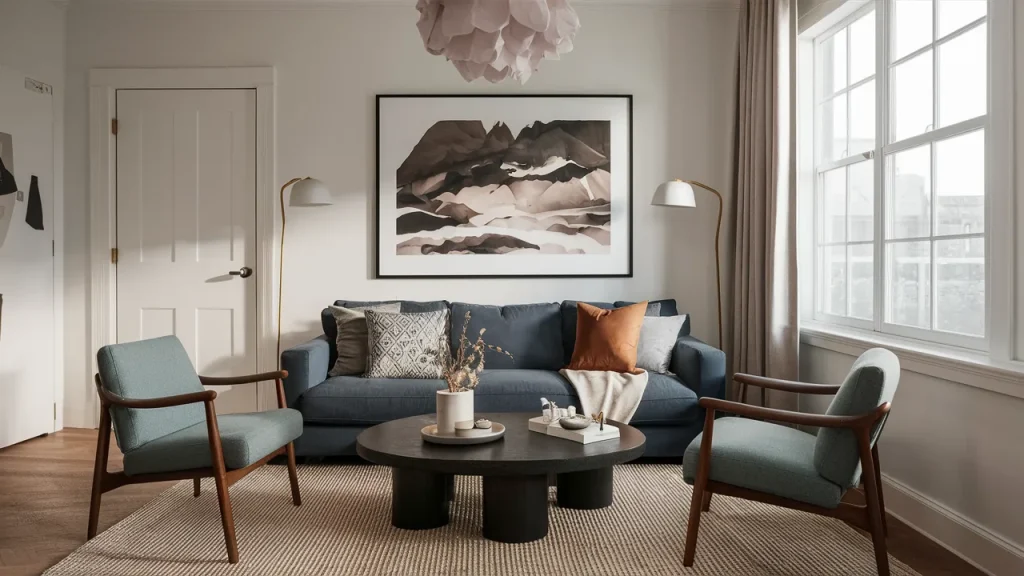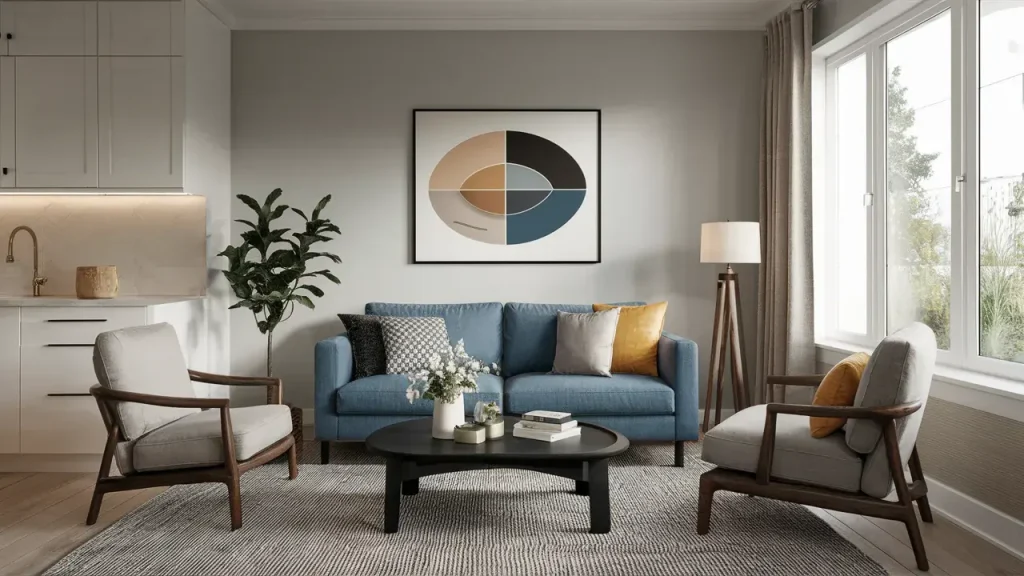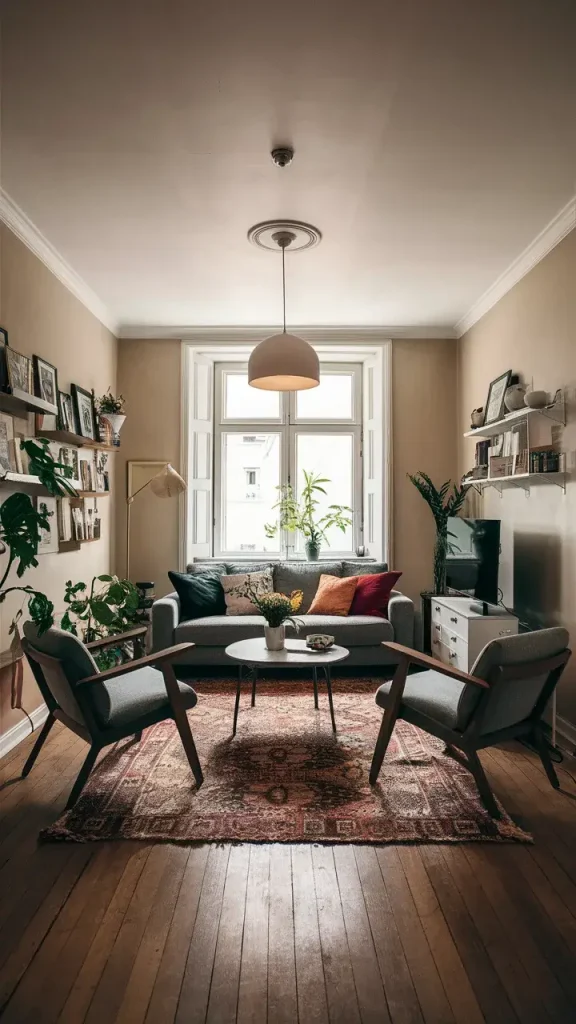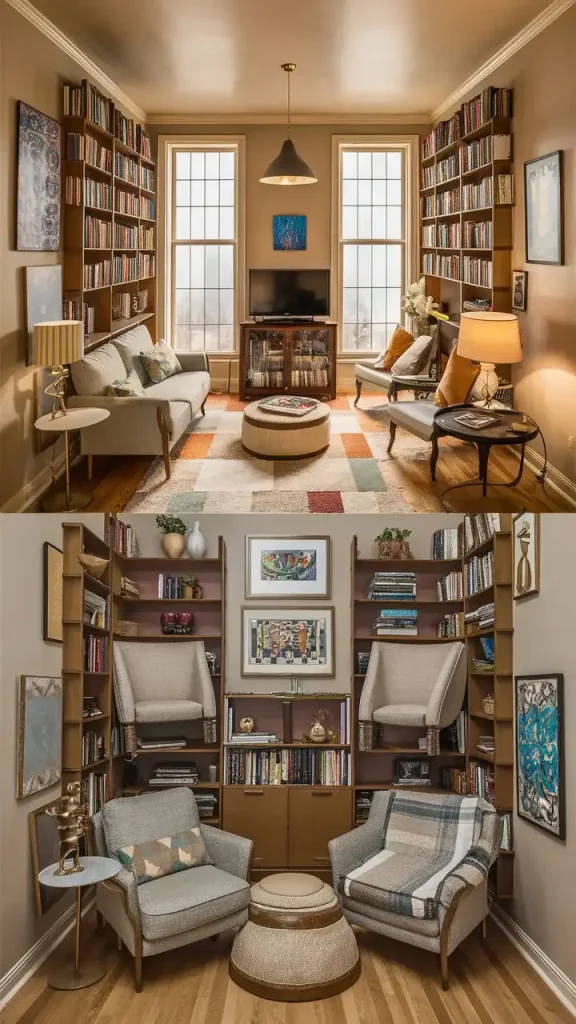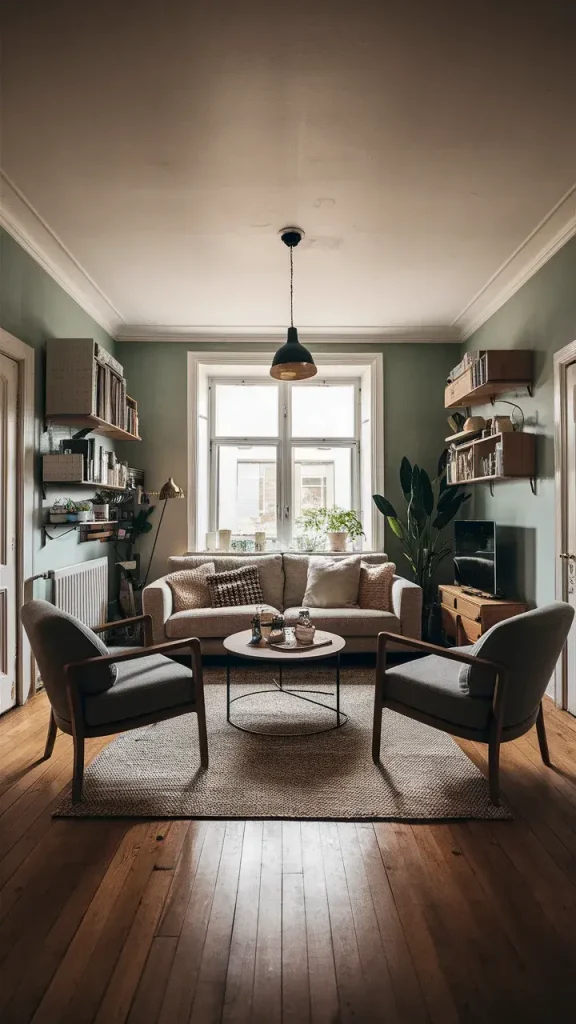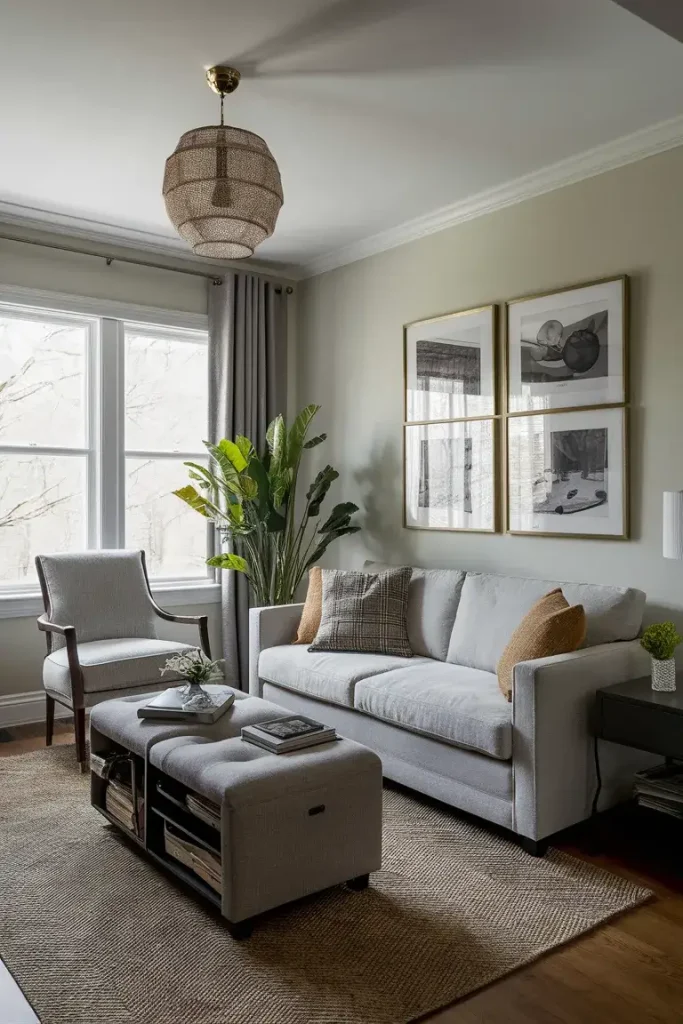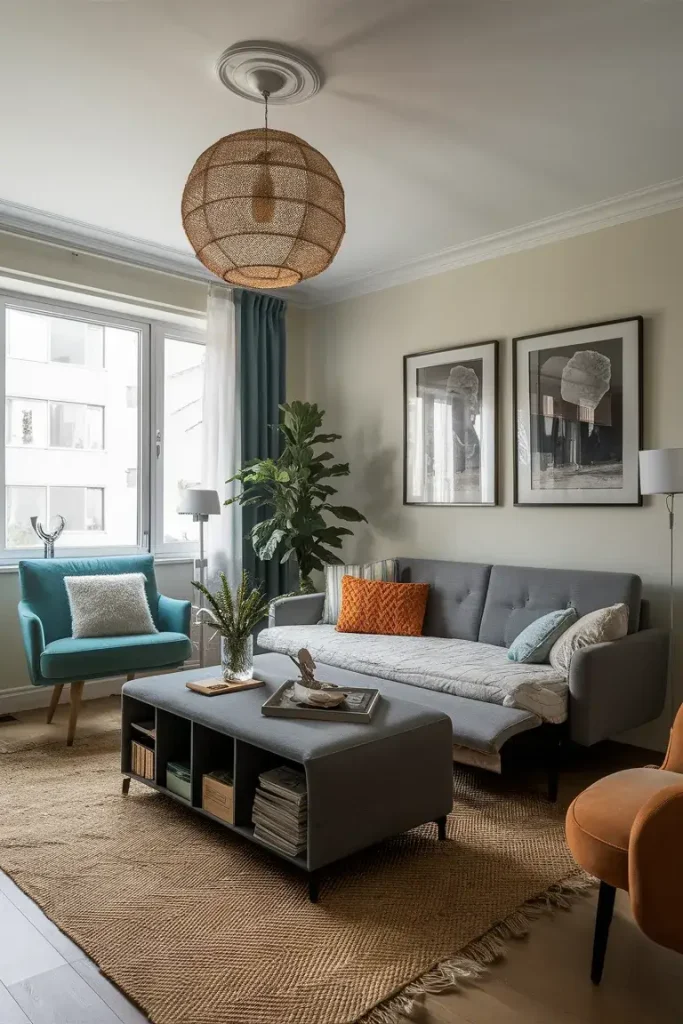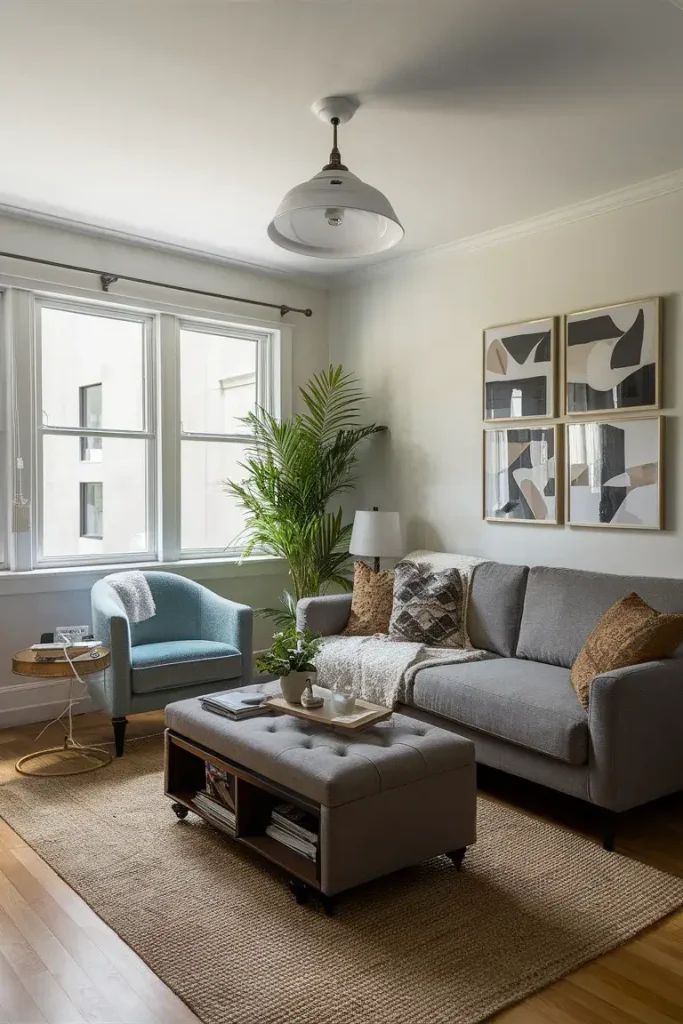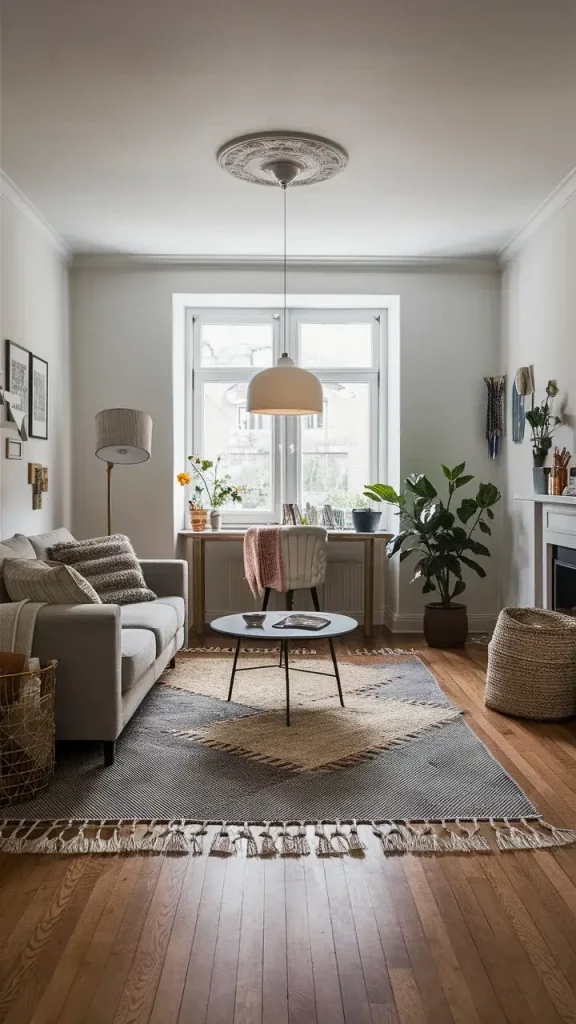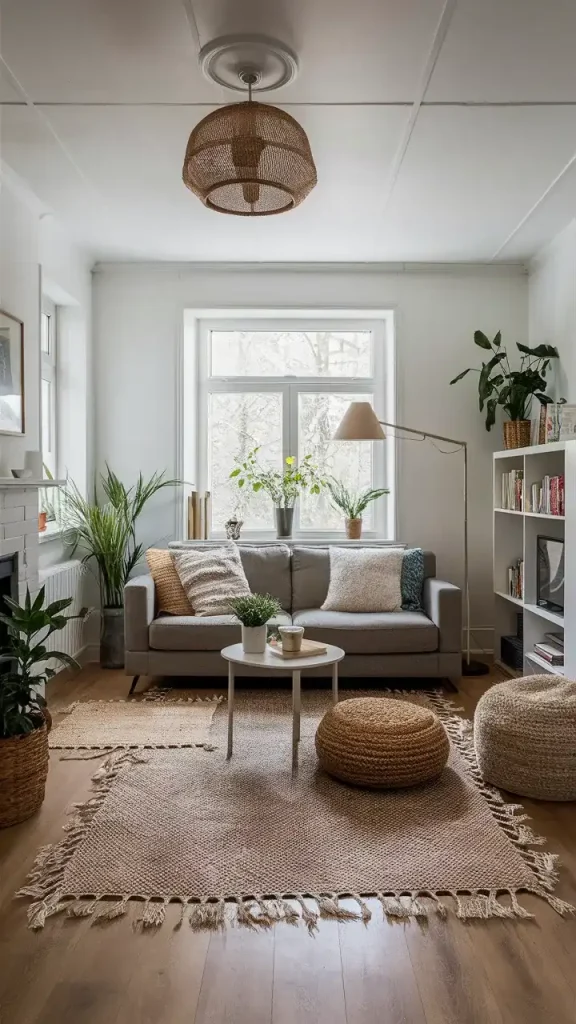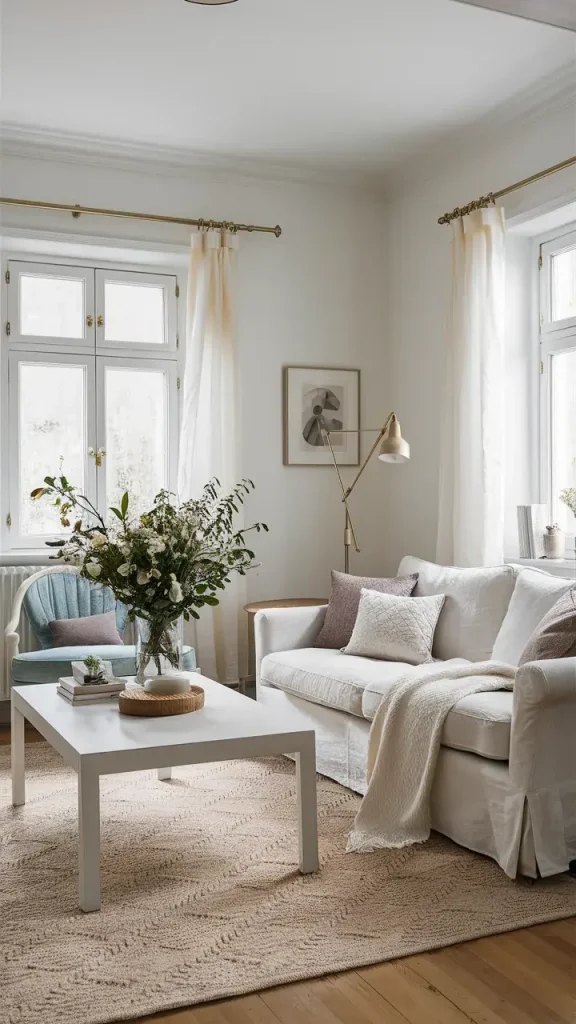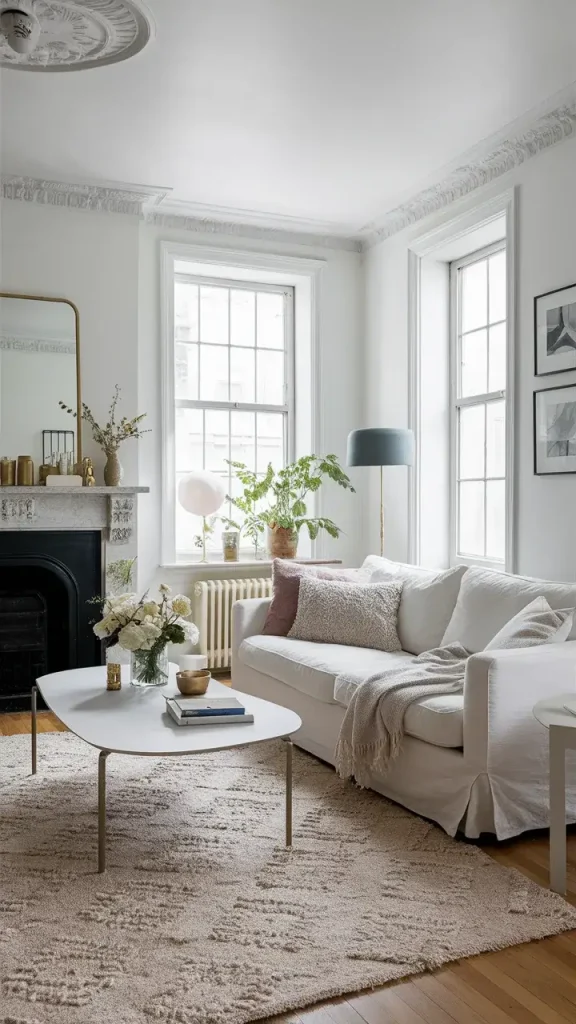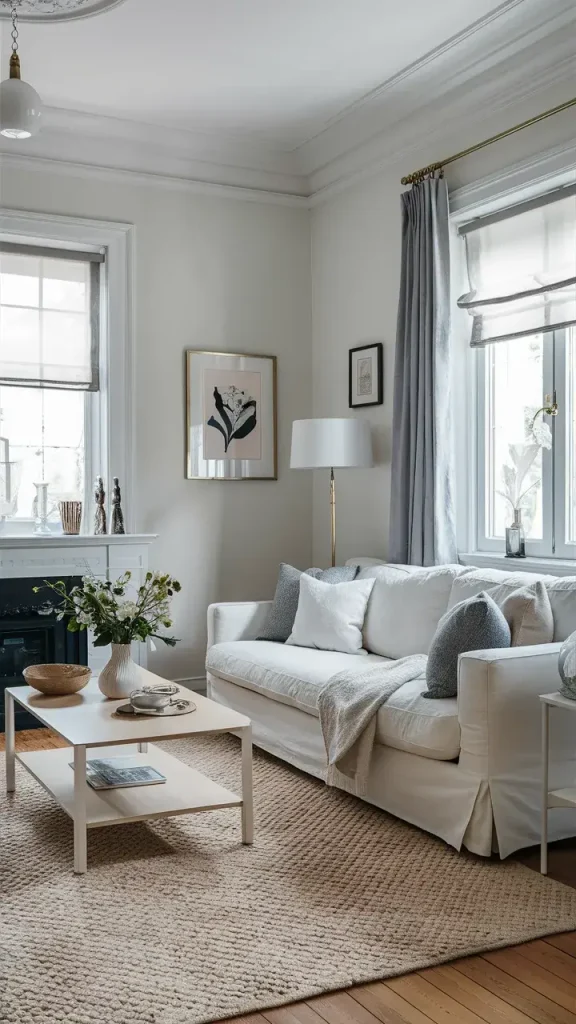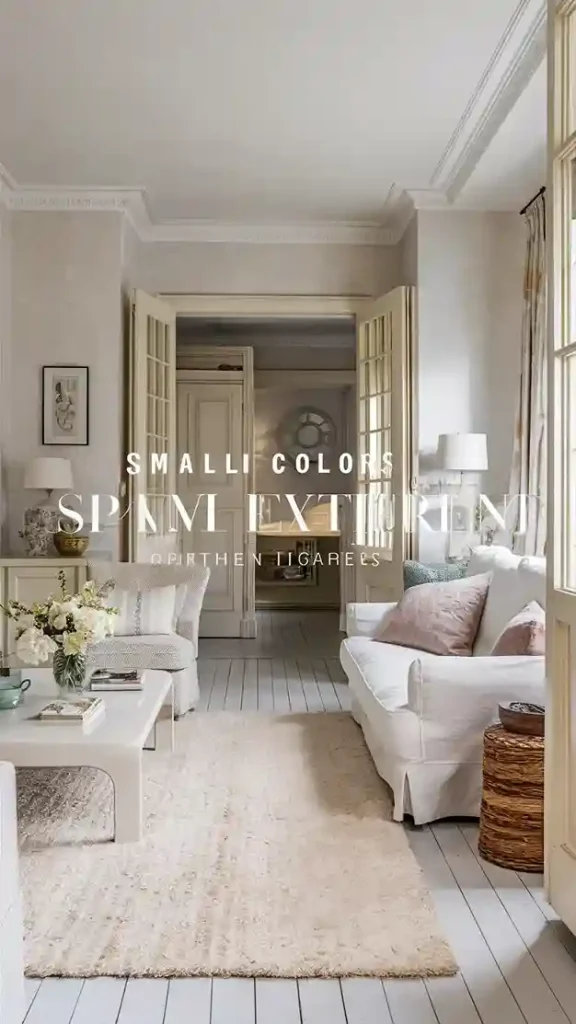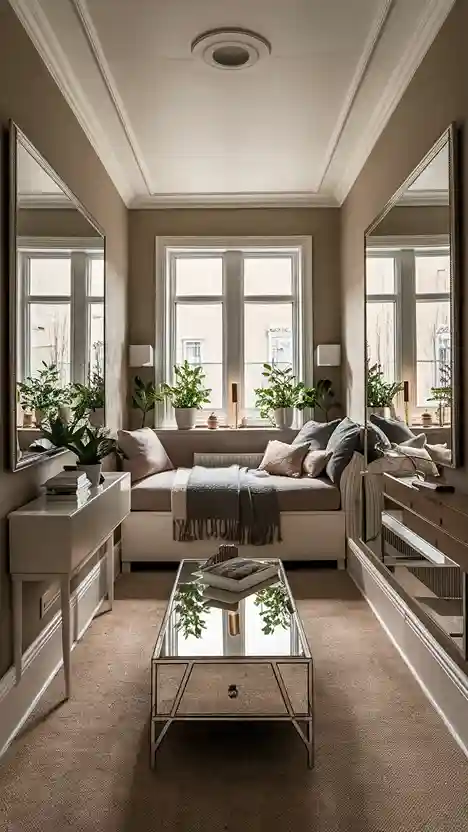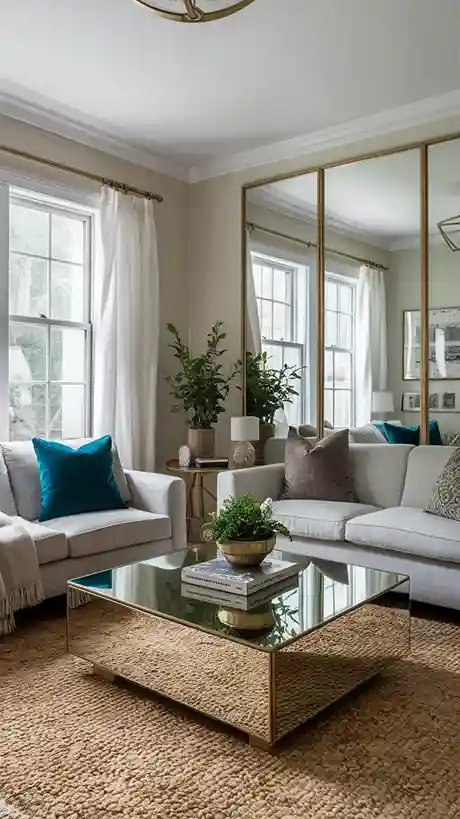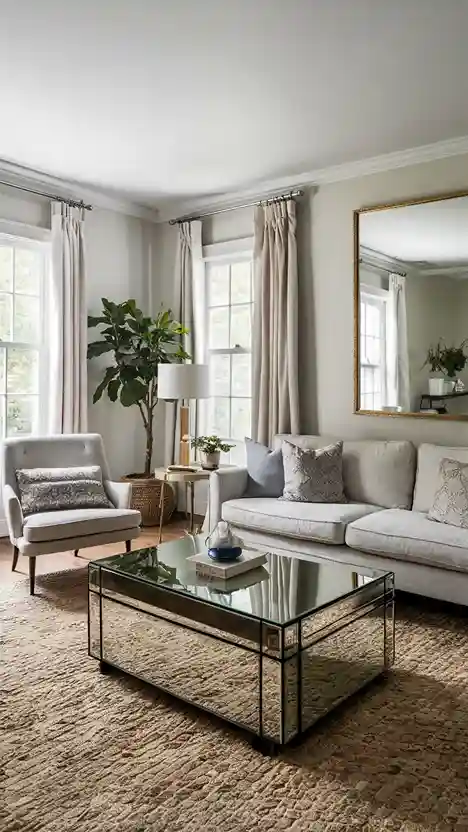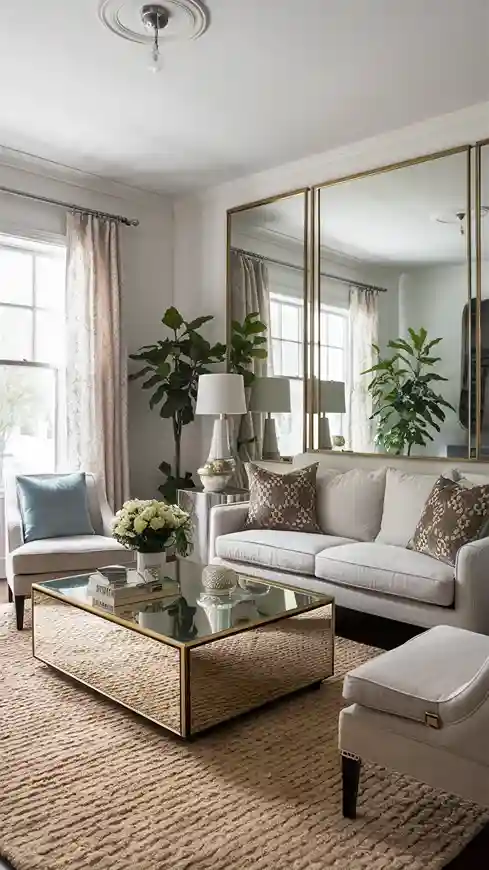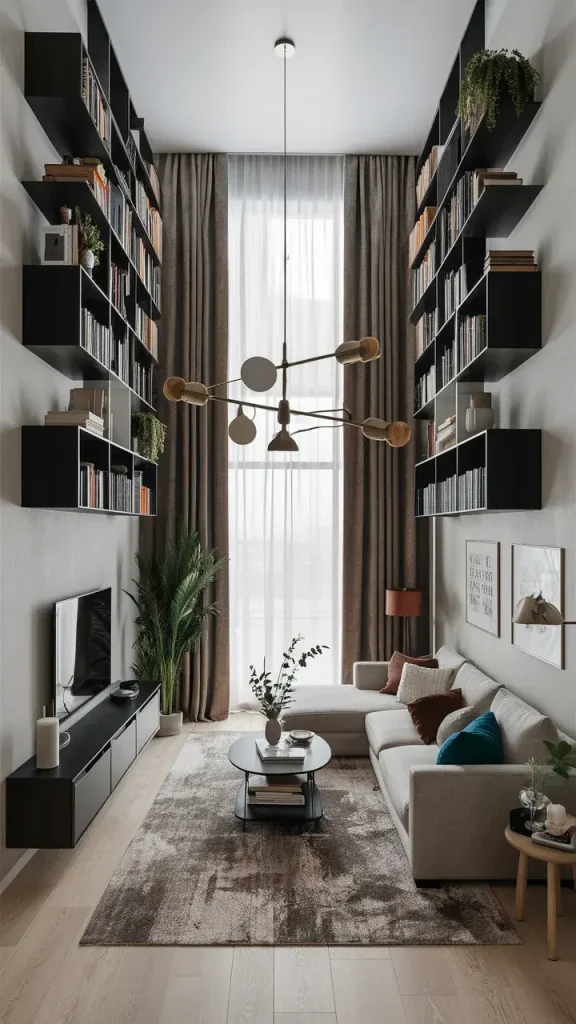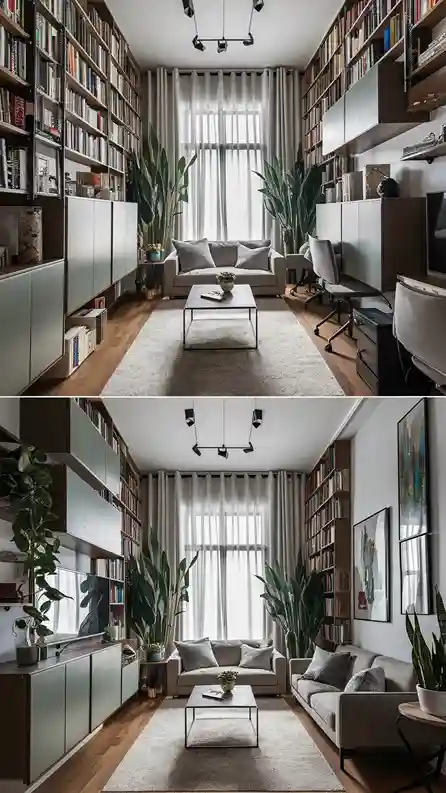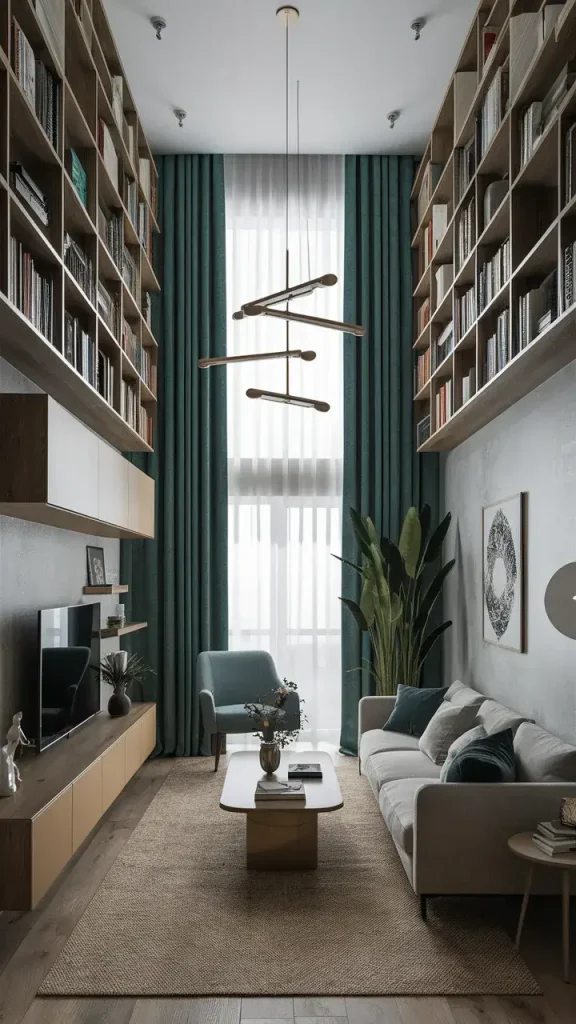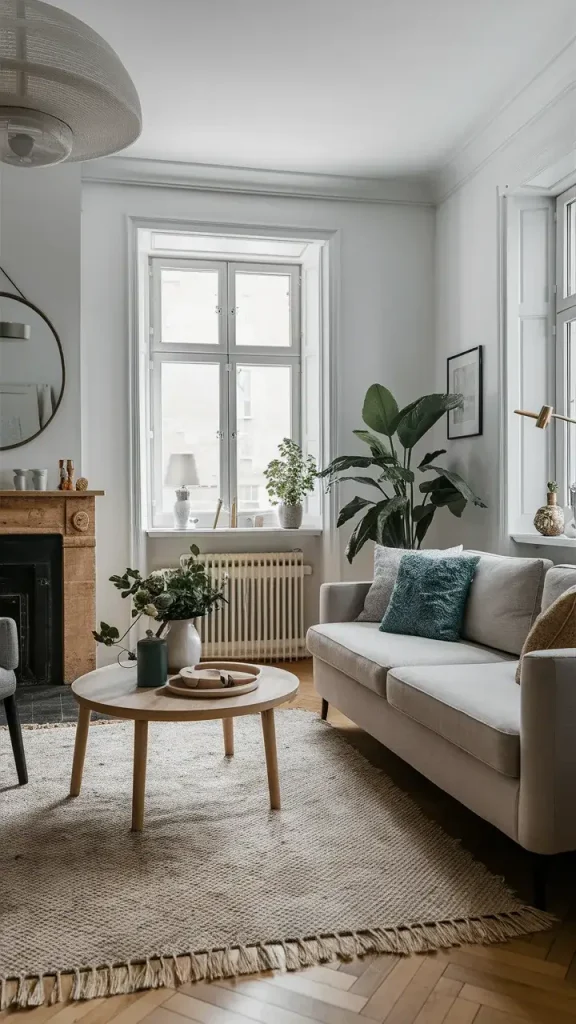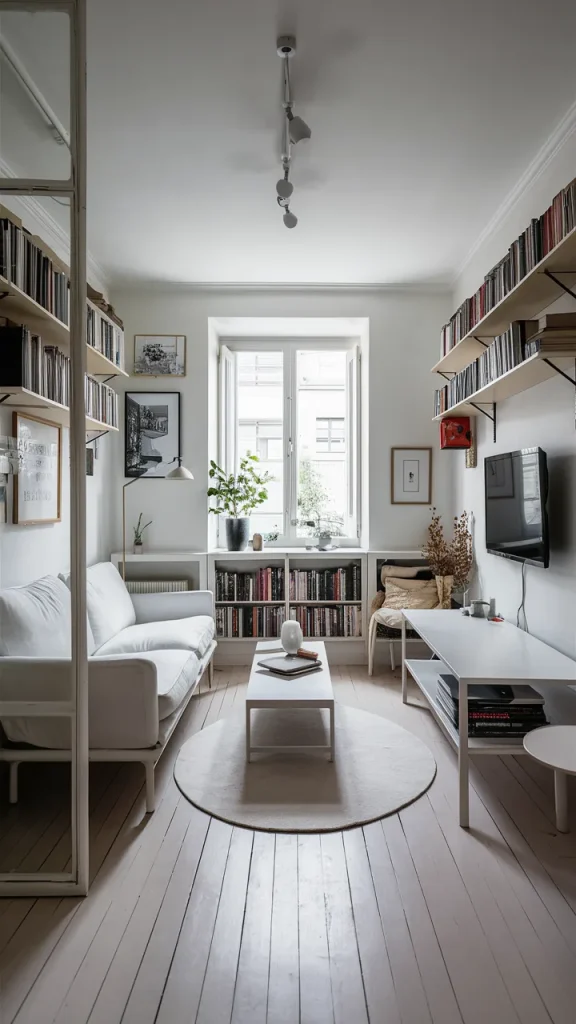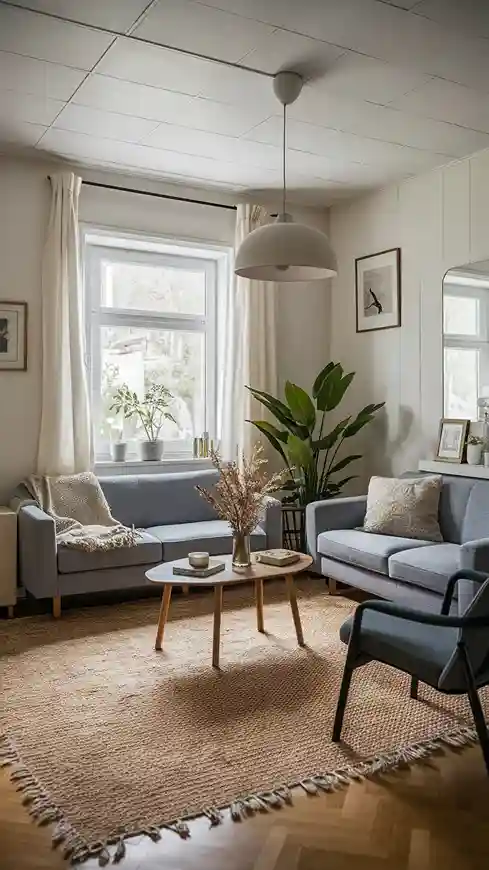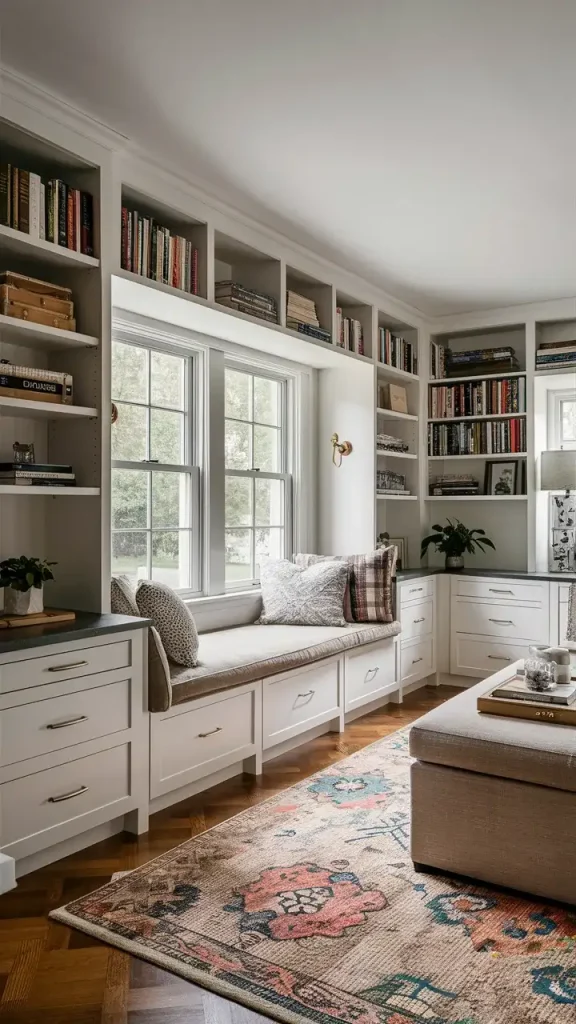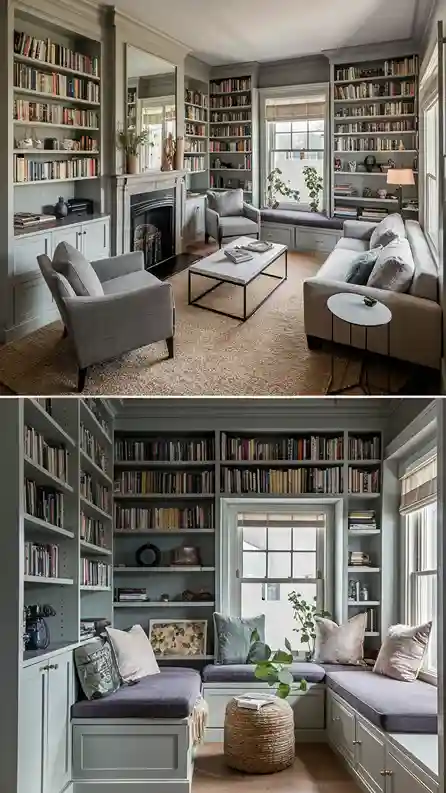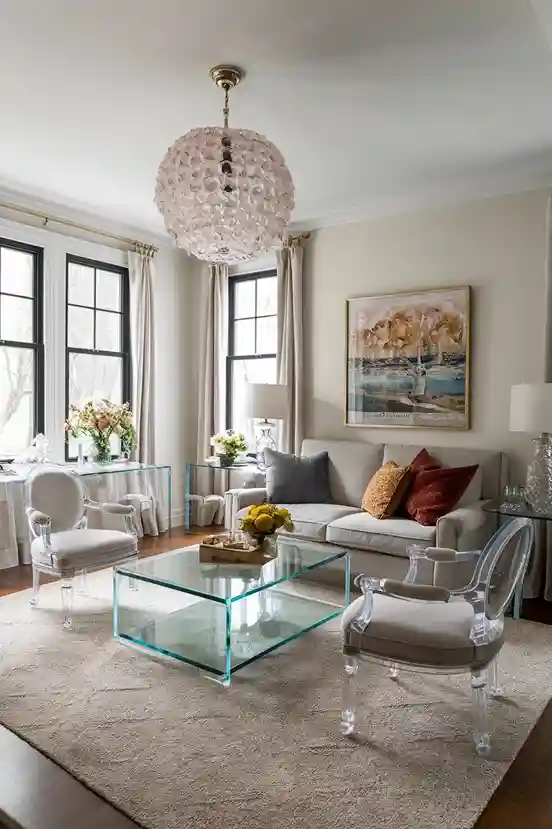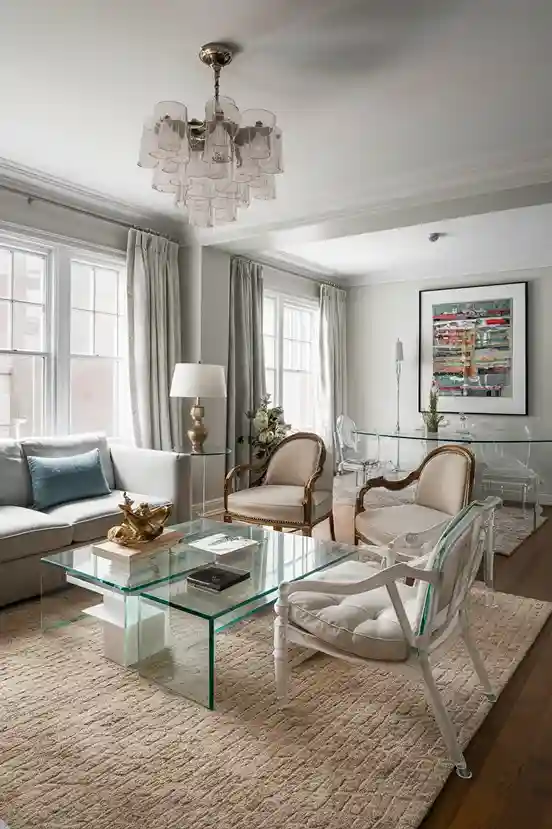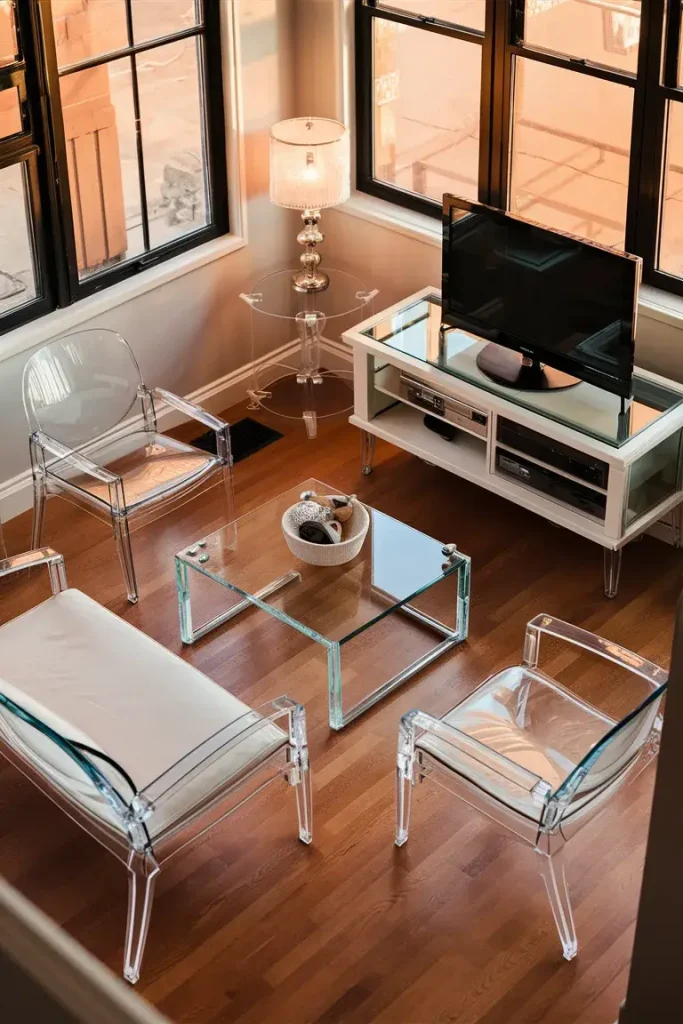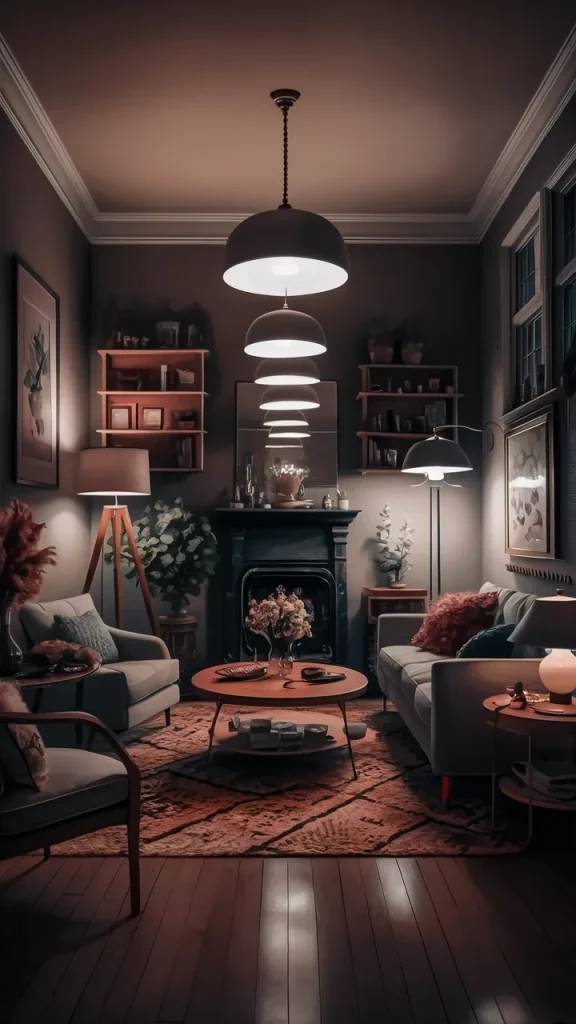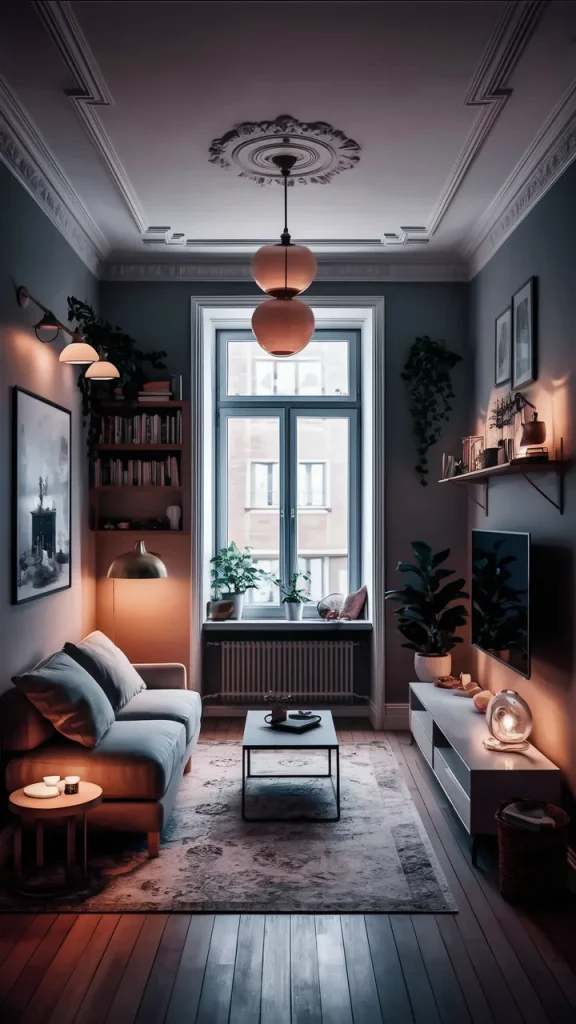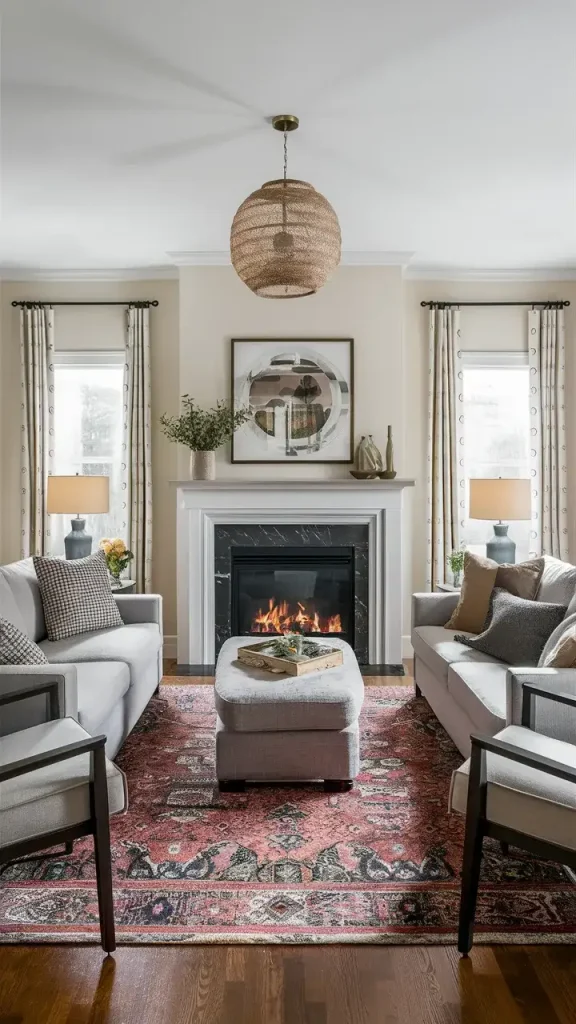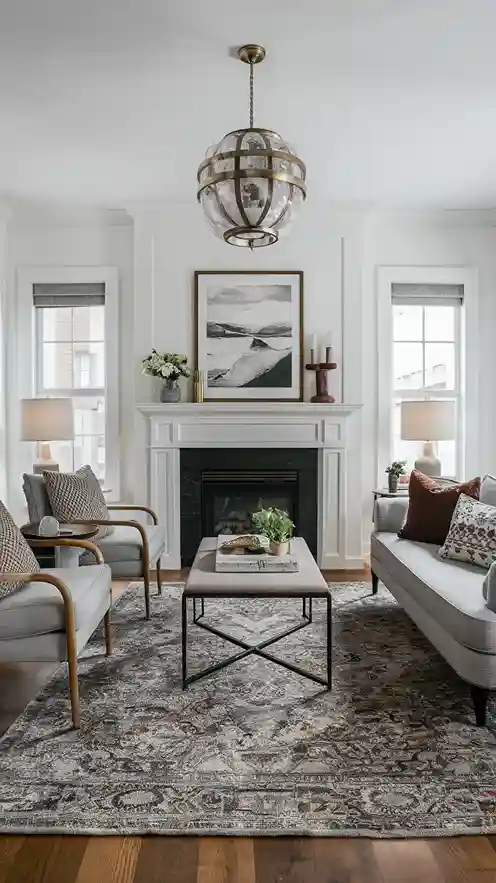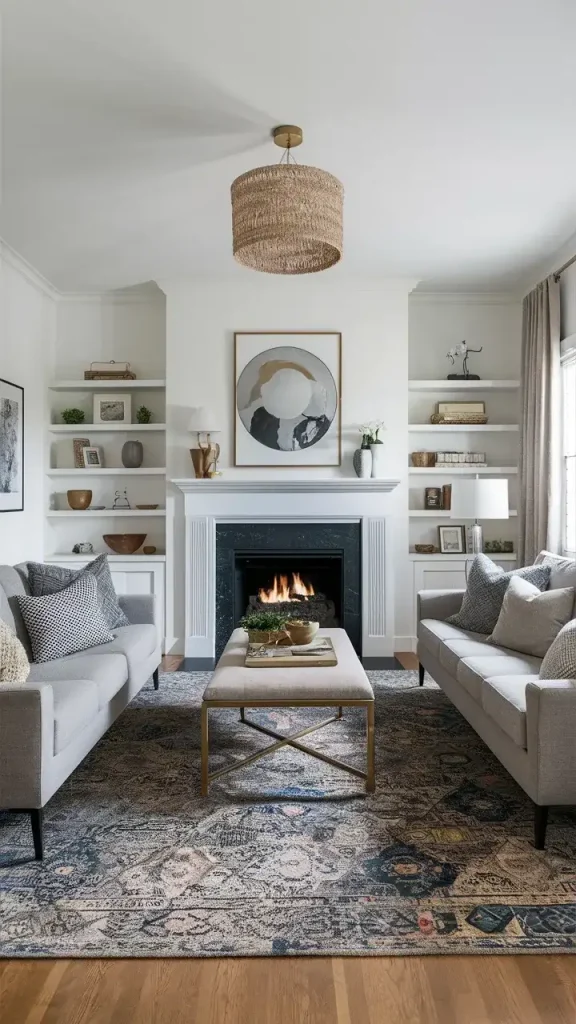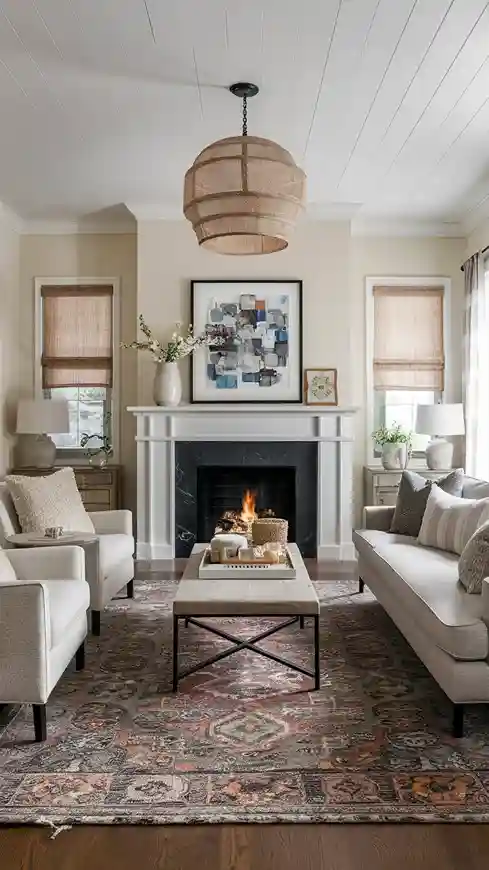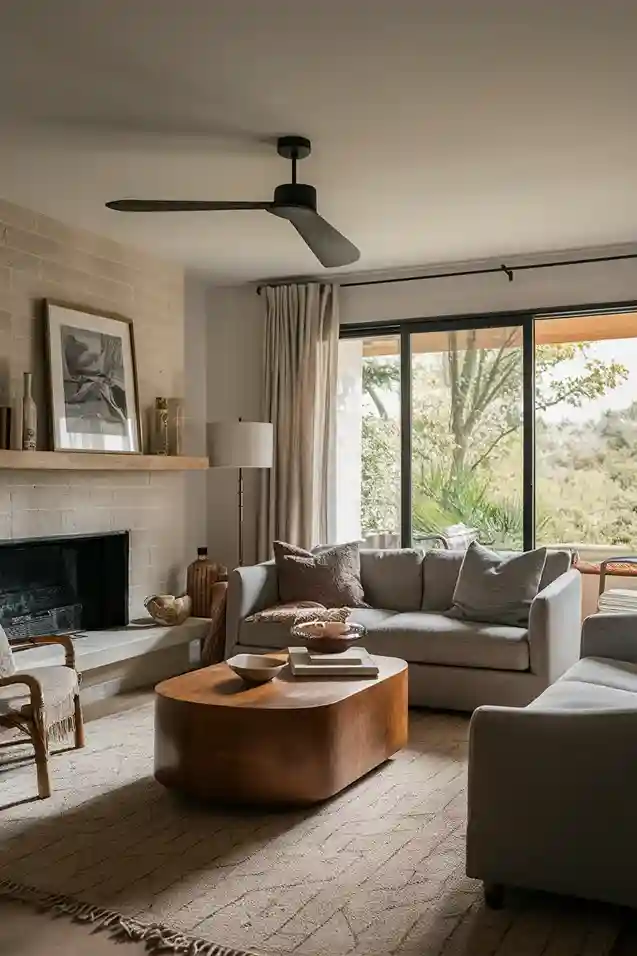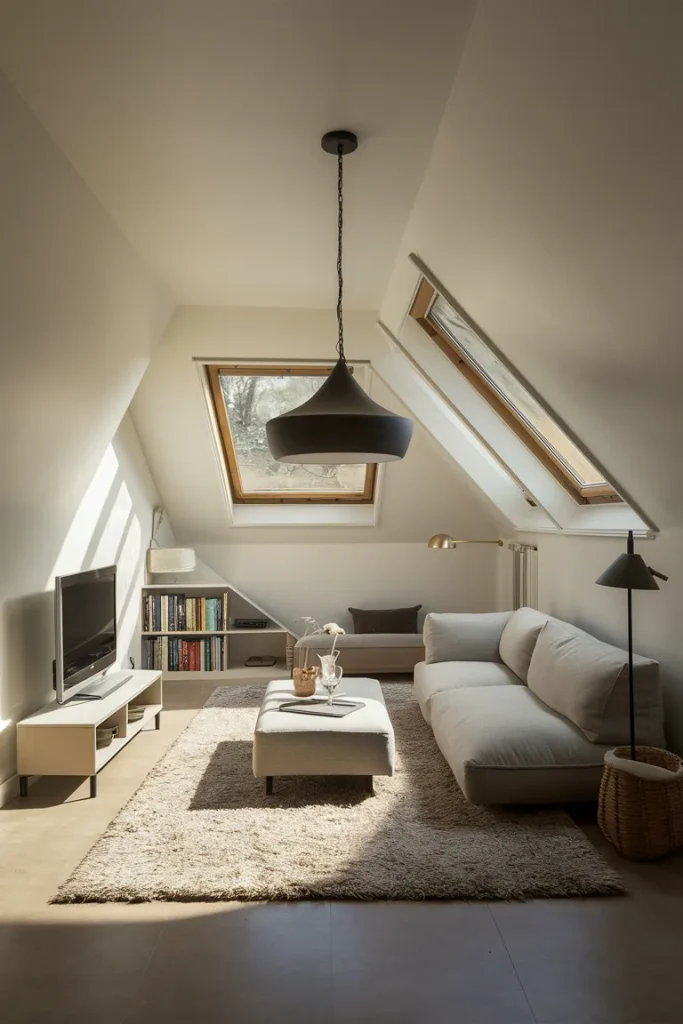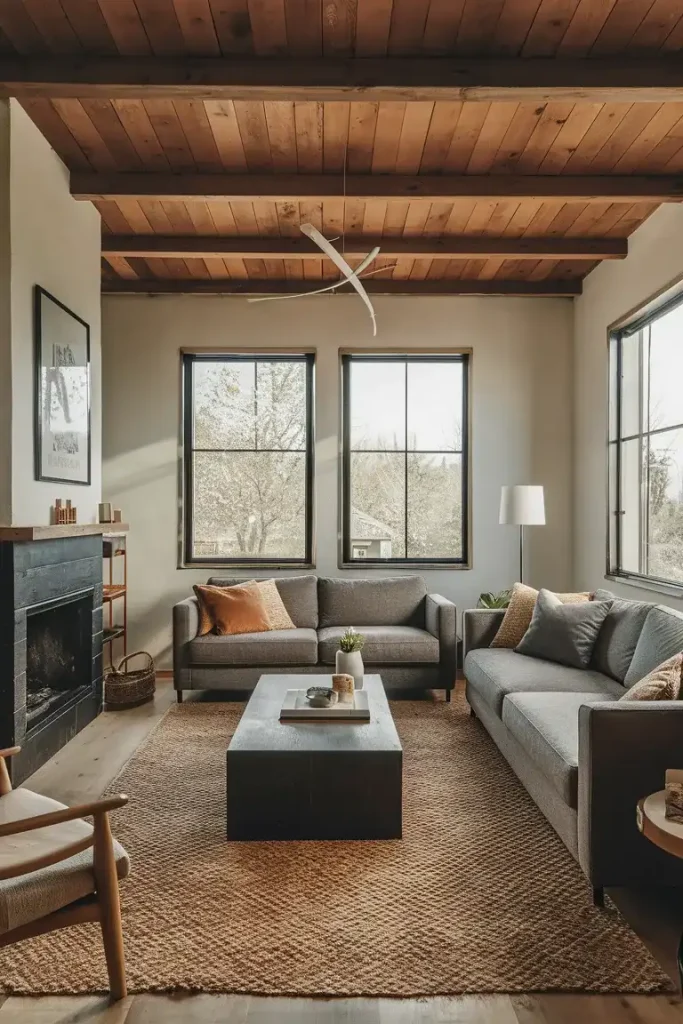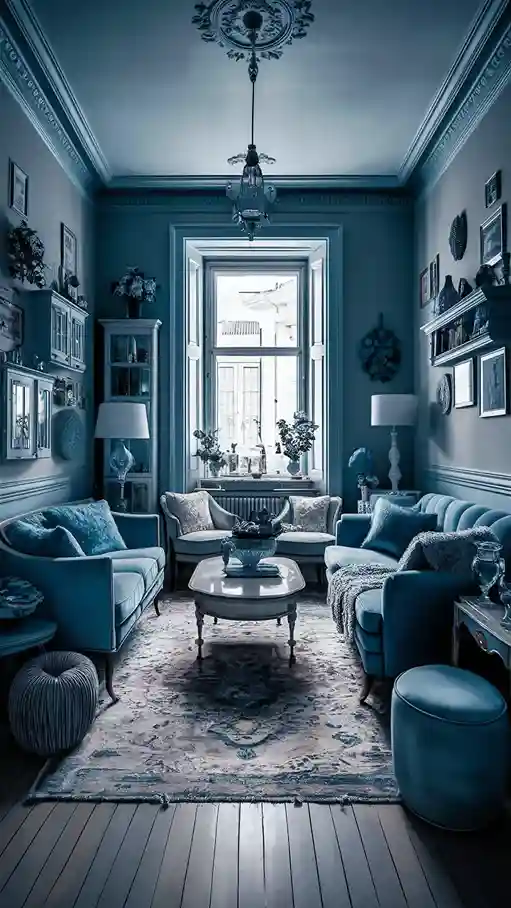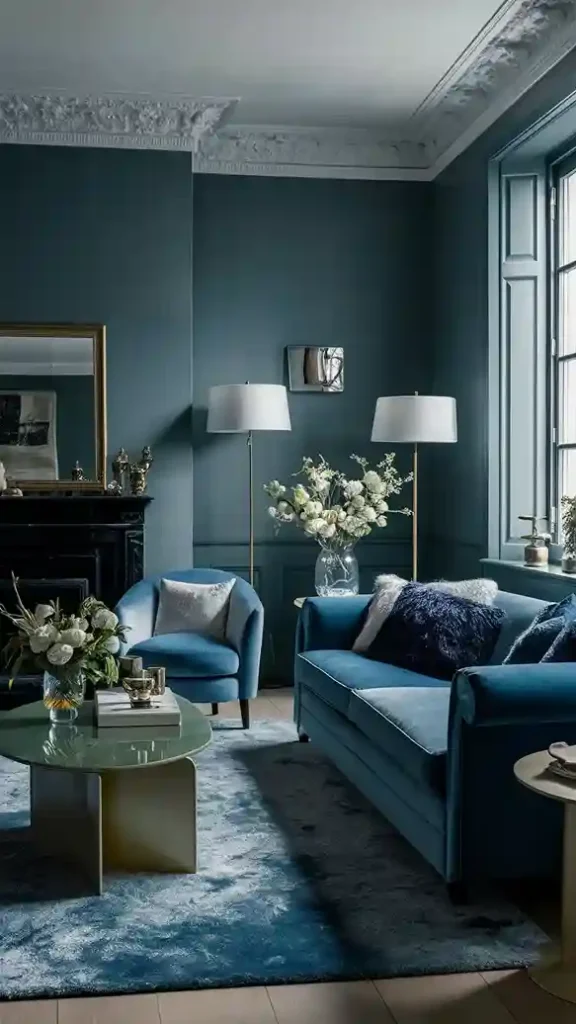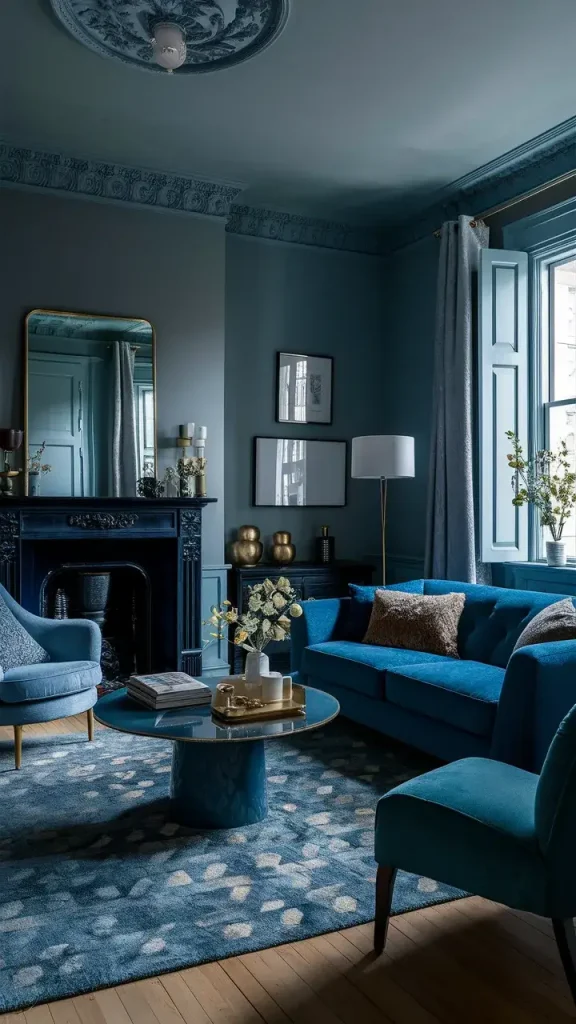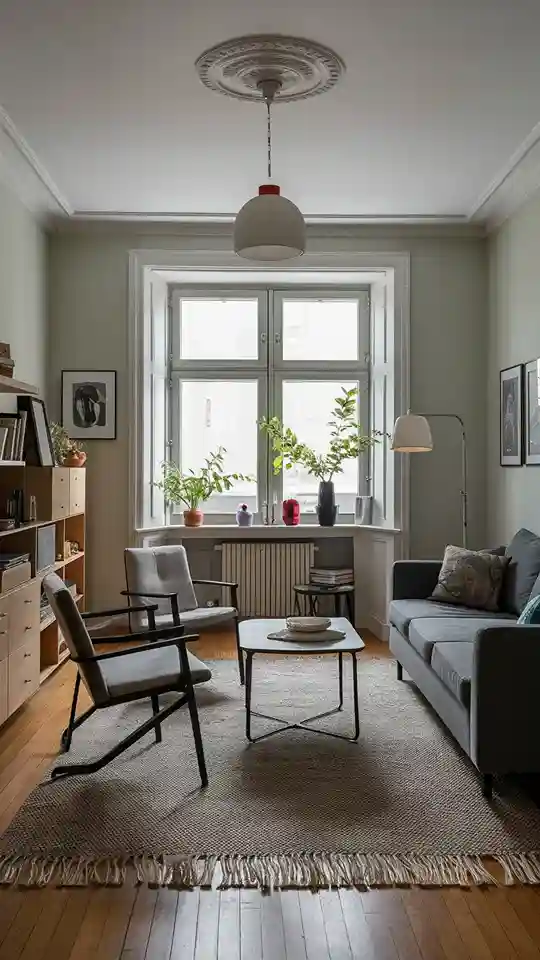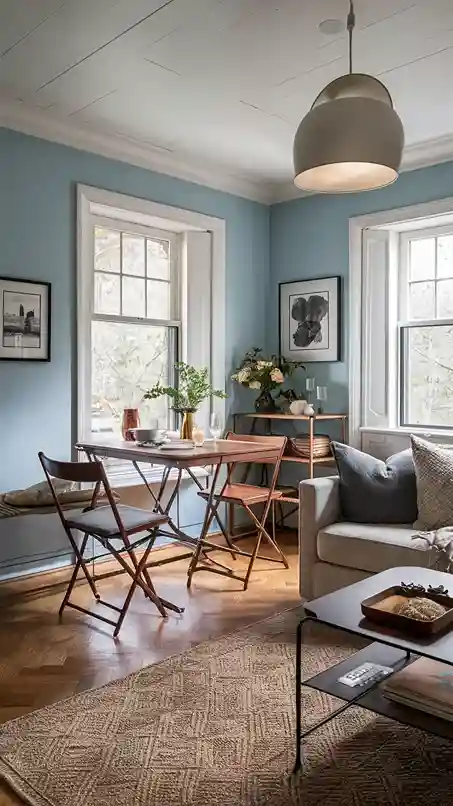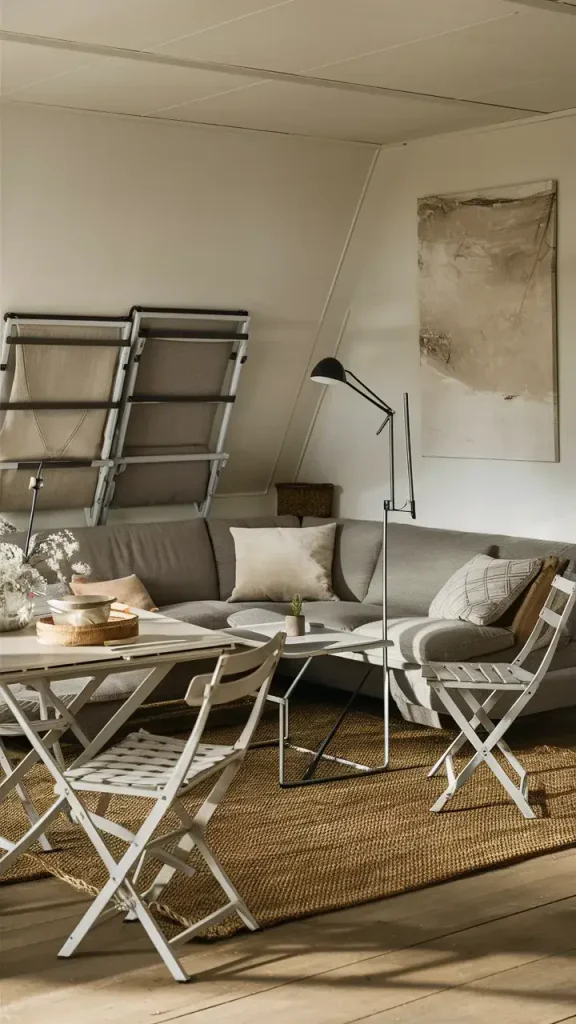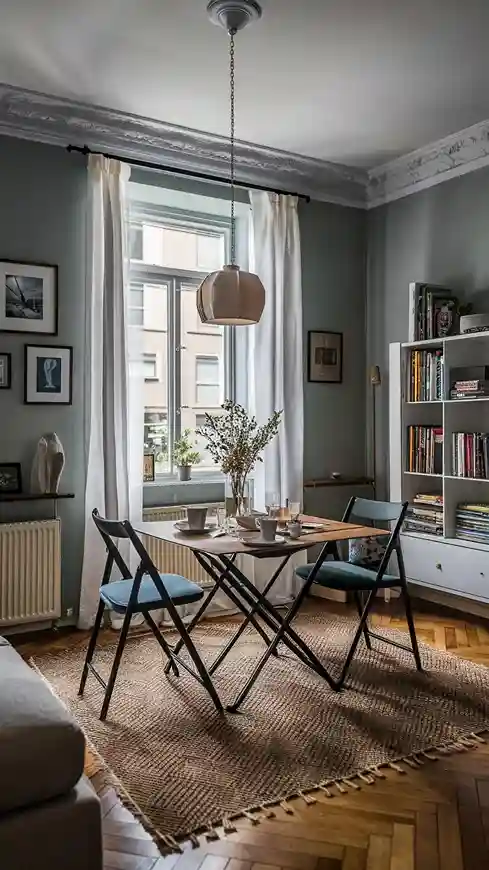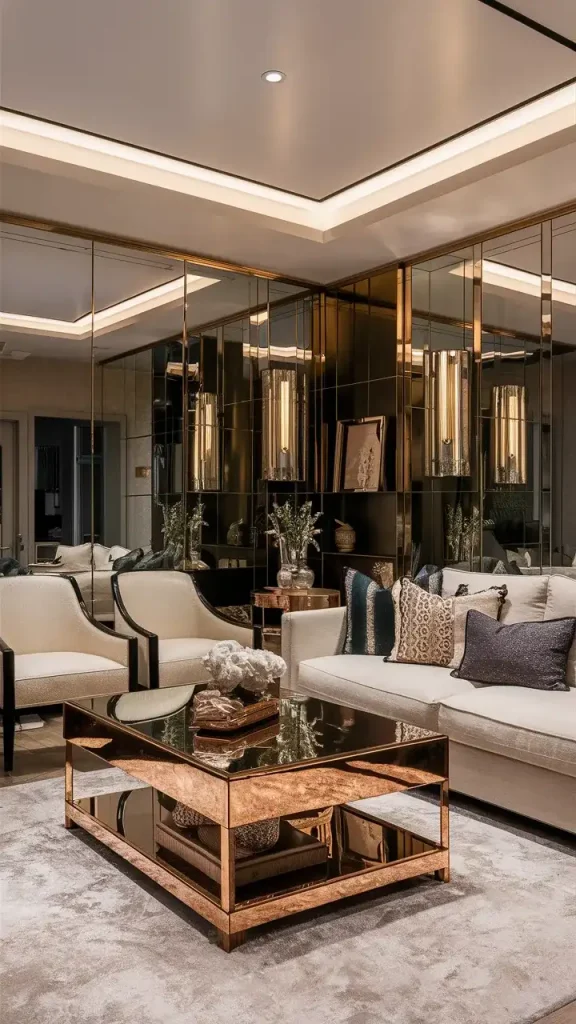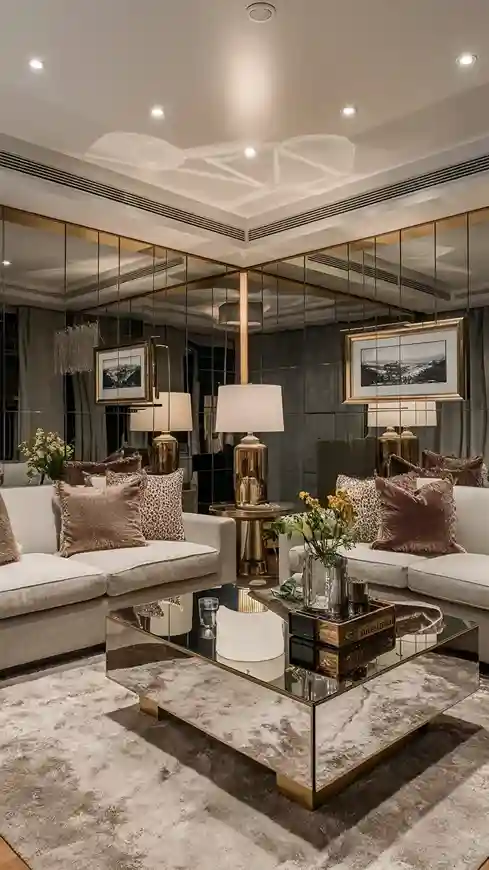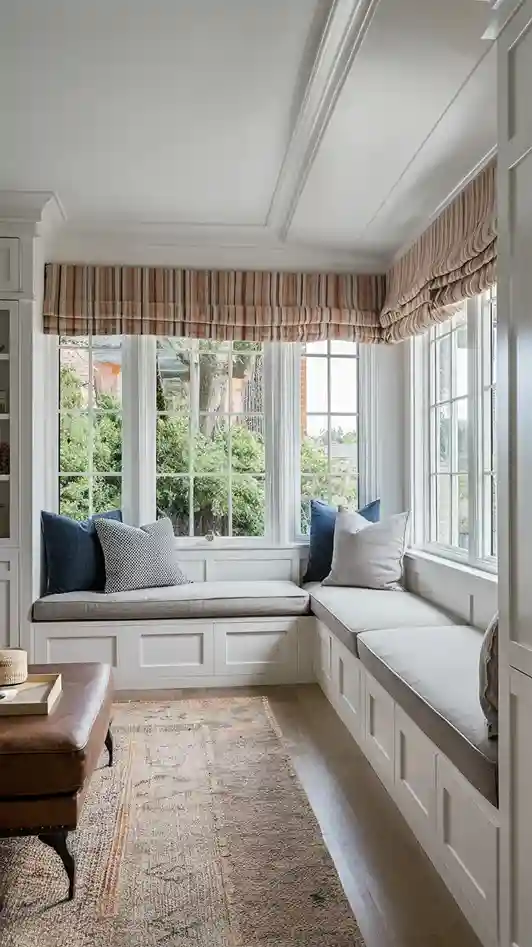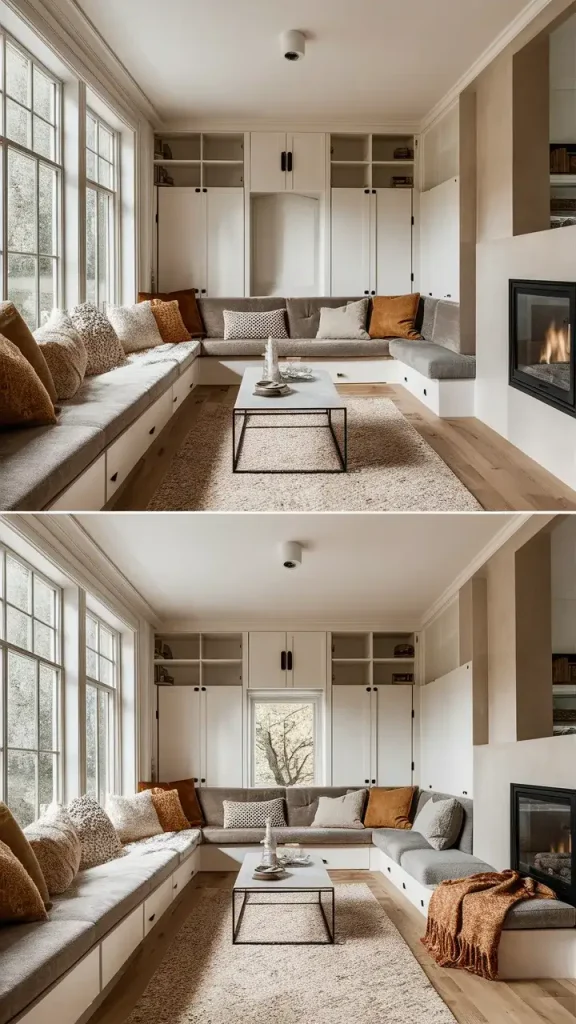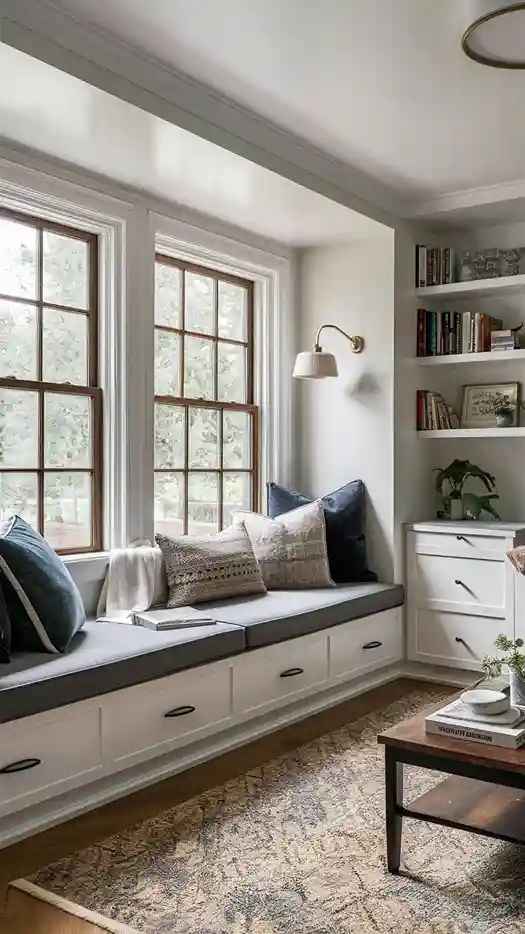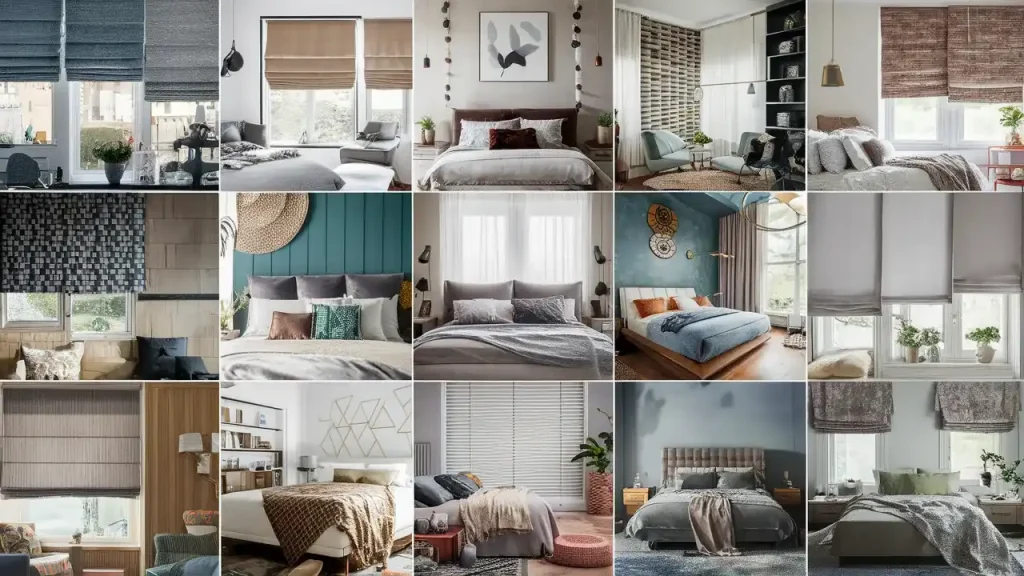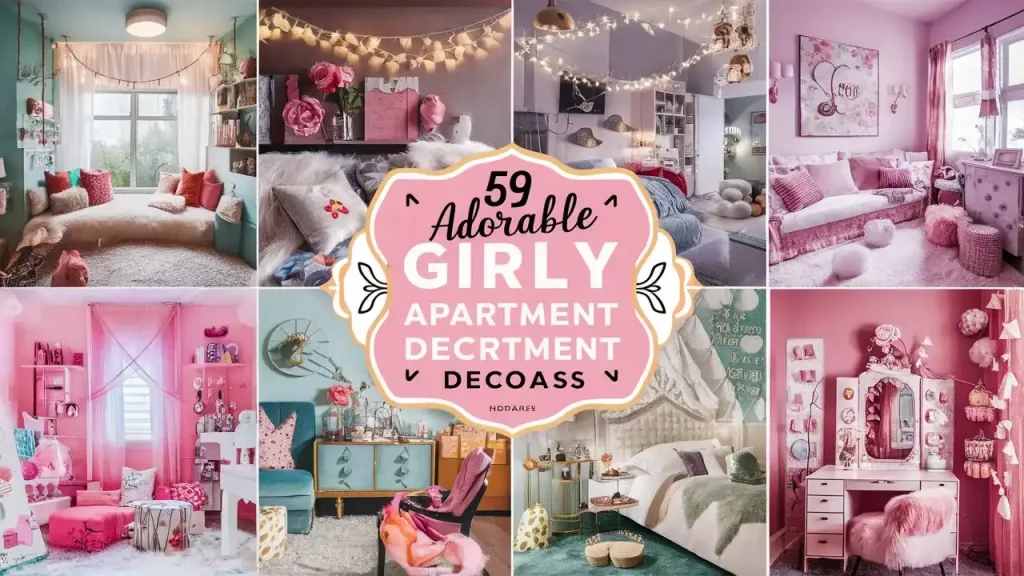Designing a small living room can be a challenging yet rewarding task. With the right layout, you can maximize your space, making it both functional and stylish.
Here are 11 small living room layout ideas to help you make the most of your space.
#1. Float the Furniture
Floating furniture away from the walls can create a more dynamic and spacious feel in a small living room. By placing a sofa or chairs in the center of the room, you can establish distinct zones for different activities. This layout encourages better flow and makes the space feel less cramped.
Additionally, floating furniture allows for more creative use of wall space, such as adding shelves or artwork, which can further enhance the room’s aesthetic. This approach also makes cleaning easier, as you can access all areas of the floor without moving heavy furniture. Floating furniture can also help to create a more intimate and cozy seating arrangement, perfect for conversations and gatherings. By breaking the traditional layout rules, you can make your small living room feel more open and inviting.
#2. Use Multi-Functional Furniture
In a small living room, every piece of furniture should serve more than one purpose. Opt for a sofa bed, a coffee table with storage, or an ottoman that doubles as a seat and a storage unit. Multi-functional furniture helps to maximize space without sacrificing comfort or style.
This approach not only saves space but also keeps the room organized and clutter-free, making it feel larger and more inviting. For example, a convertible sofa can provide seating during the day and transform into a bed at night, perfect for accommodating guests without needing a separate guest room. Similarly, a coffee table with hidden storage can keep remote controls, magazines, and other items out of sight, maintaining a tidy and spacious appearance. Multi-functional furniture is a smart investment for any small living room, offering both practicality and style.
#3. Create Zones with Rugs
Using rugs to define different areas within a small living room can help create a sense of order and purpose. For example, a rug under the seating area can delineate the living space, while another rug can mark a reading nook or a workspace. This technique adds visual interest and helps to break up the space, making it feel more expansive and organized.
Rugs also add warmth and texture, enhancing the overall comfort and aesthetic of the room. Choose rugs that complement your color scheme and furniture to create a cohesive look. Additionally, layering rugs can add depth and dimension to the space, making it feel more dynamic and visually appealing. By strategically placing rugs, you can create distinct zones that serve different functions, maximizing the usability of your small living room.
#4. Opt for Light Colors
Light colors can make a small living room feel larger and more open. Choose a palette of whites, creams, and pastels for the walls, furniture, and decor. Light colors reflect natural light, enhancing the room’s brightness and creating an airy atmosphere.
This approach can make even the smallest living room feel more spacious and welcoming. Additionally, light-colored furniture and accessories can help to create a seamless look, reducing visual clutter and making the space feel more cohesive and harmonious. To add depth and interest, incorporate different textures and finishes within the light color palette. For example, a white sofa with a linen texture can be paired with a glossy white coffee table and a soft cream rug. This combination of light colors and varied textures will create a sophisticated and inviting space that feels larger than it is.
#5. Use Mirrors Strategically
Mirrors are a classic trick for making a small space feel larger. Place a large mirror on one wall to reflect light and create the illusion of depth. You can also use mirrored furniture or decor to add a touch of elegance while enhancing the room’s sense of space.
Mirrors not only brighten the room but also make it feel more open and airy. Consider placing mirrors opposite windows to maximize the amount of natural light reflected throughout the room, further enhancing the sense of space and light. Additionally, mirrored surfaces on furniture, such as a mirrored coffee table or console, can add a touch of glamour while serving a practical purpose. By strategically placing mirrors, you can create a brighter, more open, and visually appealing living room that feels larger than its actual size.
#6. Maximize Vertical Space
When floor space is limited, look up. Utilize vertical space by installing tall bookshelves, wall-mounted cabinets, or floating shelves. This approach keeps the floor clear and provides ample storage for books, decor, and other items. Vertical storage solutions draw the eye upward, making the room feel taller and more spacious.
Additionally, vertical elements can add visual interest and create a more dynamic and layered look in your living room, enhancing both functionality and aesthetics. Consider using floor-to-ceiling curtains to emphasize the height of the room and create a sense of grandeur. Tall plants or vertical artwork can also contribute to the vertical emphasis, making the space feel more open and airy. By maximizing vertical space, you can effectively increase the storage capacity and visual appeal of your small living room.
#7. Choose Slimline Furniture
Opt for furniture with slim profiles and legs that lift pieces off the floor. This style of furniture creates a sense of openness and allows light to flow underneath, making the room feel less cluttered. Slimline furniture is both functional and stylish, perfect for maintaining a spacious feel in a small living room.
Pieces with exposed legs and minimalistic designs can help to create a more airy and open atmosphere, making the most of the available space without overwhelming it. Additionally, slimline furniture often features clean lines and simple shapes, which contribute to a modern and uncluttered look. By choosing furniture that is appropriately scaled for the room, you can create a balanced and harmonious layout that maximizes both comfort and space. Slimline furniture is an excellent choice for small living rooms, offering both practicality and aesthetic appeal.
#8. Incorporate Built-In Storage
Built-in storage solutions, such as shelves and cabinets, can save valuable floor space and keep the room organized. Custom-built units can be designed to fit awkward spaces and provide ample storage for books, electronics, and decor. Built-ins blend seamlessly with the room’s architecture, creating a cohesive and uncluttered look.
This approach not only maximizes storage but also enhances the overall aesthetic of the room, making it feel more spacious and well-organized. Consider incorporating built-in seating with storage underneath, such as a window seat or banquette, to further optimize space. Built-in storage can also be designed to showcase decorative items, adding a personal touch to the room. By integrating built-in storage solutions, you can create a functional and visually appealing living room that makes the most of every inch of space.
#9. Use Transparent Furniture
Transparent furniture, such as glass coffee tables or acrylic chairs, can make a small living room feel more open. These pieces take up less visual space, allowing the room to appear larger and less cluttered. Transparent furniture is also versatile and can complement various design styles, from modern to traditional.
By reducing visual barriers, transparent furniture helps to create a more seamless and airy look, enhancing the overall sense of space and light in the room. Additionally, transparent furniture can add a touch of sophistication and elegance, making the space feel more refined. Consider using a glass dining table or acrylic side tables to maintain an open and unobstructed view. By incorporating transparent furniture, you can create a visually light and spacious living room that feels larger and more inviting.
#10. Layer Your Lighting
Layered lighting can enhance the ambiance and functionality of a small living room. Combine overhead lighting with floor lamps, table lamps, and wall sconces to create a warm and inviting atmosphere. Layered lighting not only brightens the room but also adds depth and dimension, making the space feel larger and more comfortable.
Use dimmable lights to adjust the mood and create different lighting scenarios for various activities, from reading to entertaining. Additionally, consider incorporating accent lighting to highlight artwork or architectural features, adding visual interest and enhancing the room’s overall aesthetic. By layering different types of lighting, you can create a versatile and dynamic living room that feels both cozy and spacious. Proper lighting can transform a small living room into a welcoming and functional space that meets all your needs.
#11. Create a Focal Point
A focal point can anchor a small living room and draw attention away from its size. This could be a fireplace, a piece of artwork, or a statement piece of furniture. By focusing on a central element, you can create a sense of balance and harmony in the room, making it feel more cohesive and spacious.
A well-chosen focal point can also add personality and style to the space, enhancing its overall aesthetic appeal. Arrange furniture around the focal point to create a natural flow and encourage conversation. Additionally, use lighting and decor to highlight the focal point, making it the star of the room. By creating a strong focal point, you can distract from the room’s small size and make it feel more intentional and thoughtfully designed.
#12. Use Low-Profile Furniture
Low-profile furniture, such as low sofas and coffee tables, can make a small living room feel more open. These pieces create a sense of space by allowing more of the room to be visible. Low-profile furniture also encourages a relaxed and casual atmosphere, perfect for a cozy and inviting living room.
This approach helps to maintain a clear line of sight across the room, making it feel less cluttered and more expansive. Additionally, low-profile furniture often features sleek and modern designs, contributing to a contemporary and uncluttered look. By choosing furniture that sits low to the ground, you can create a more open and airy feel, making the most of the available space. Low-profile furniture is an excellent choice for small living rooms, offering both comfort and style.
#13. Opt for a Monochromatic Color Scheme
A monochromatic color scheme can create a seamless and cohesive look in a small living room. Choose different shades of the same color for the walls, furniture, and decor. This approach minimizes visual clutter and creates a sense of continuity, making the room feel larger and more harmonious.
Monochromatic schemes can also add a touch of sophistication and elegance, enhancing the overall aesthetic of the space. To add depth and interest, incorporate different textures and finishes within the monochromatic palette. For example, a room decorated in various shades of blue can feature a velvet sofa, a silk rug, and a glossy coffee table. This combination of colors and textures will create a rich and layered look, making the room feel more dynamic and visually appealing. By opting for a monochromatic color scheme, you can create a stylish and spacious living room that feels cohesive and well-designed.
#14. Use Foldable Furniture
Foldable furniture, such as folding chairs and tables, can be easily stored away when not in use, freeing up valuable floor space. This type of furniture is perfect for small living rooms that need to accommodate different activities. Foldable pieces are also versatile and can be used in various settings, from casual to formal.
This approach allows you to maintain a flexible and adaptable living space, making the most of the available area without compromising on functionality or style. For example, a folding dining table can be expanded for meals and then folded away to create more space for other activities. Similarly, folding chairs can be stored in a closet or under a bed when not needed. By incorporating foldable furniture, you can create a versatile and efficient living room that meets all your needs.
#15. Incorporate Reflective Surfaces
Reflective surfaces, such as glossy finishes and metallic accents, can enhance the sense of space in a small living room. These surfaces reflect light and create a sense of depth, making the room feel brighter and more open. Reflective elements can be incorporated into furniture, decor, and even wall treatments for a stylish and spacious look.
This approach not only enhances the room’s aesthetic but also maximizes the available light, creating a more inviting and comfortable atmosphere. Consider using a mirrored coffee table, metallic picture frames, or glossy wall panels to add a touch of glamour and sophistication. By incorporating reflective surfaces, you can create a visually dynamic and spacious living room that feels larger and more luxurious.
#16. Use Built-In Seating
Built-in seating, such as window seats or banquettes, can save space and provide additional storage. These custom solutions can be designed to fit the room’s dimensions perfectly, maximizing every inch of space. Built-in seating is both functional and stylish, adding a unique and personalized touch to the living room.
This approach also helps to create a more cohesive and integrated look, enhancing the overall functionality and aesthetic of the space. Consider incorporating built-in storage underneath the seating to keep items organized and out of sight. Built-in seating can also be designed to blend seamlessly with the room’s architecture, creating a harmonious and uncluttered look. By incorporating built-in seating, you can create a comfortable and efficient living room that makes the most of the available space.
#17. Choose Furniture with Exposed Legs
Furniture with exposed legs creates a sense of openness by allowing light to flow underneath. This style of furniture makes the room feel less cluttered and more spacious. Exposed legs can be found on sofas, chairs, and tables, adding a touch of elegance and sophistication to the living room.
This approach helps to maintain a clear line of sight across the room, making it feel more open and airy. Additionally, furniture with exposed legs often features sleek and modern designs, contributing to a contemporary and uncluttered look. By choosing furniture that is appropriately scaled for the room, you can create a balanced and harmonious layout that maximizes both comfort and space. Furniture with exposed legs is an excellent choice for small living rooms, offering both practicality and aesthetic appeal.
#18. Use Large-Scale Art
Large-scale art can make a bold statement in a small living room and draw attention away from its size. Choose a single large piece or a few oversized pieces to create a focal point. Large-scale art adds visual interest and can make the room feel more expansive and dynamic.
This approach helps to create a more cohesive and balanced look, enhancing the overall aesthetic of the space. When selecting large-scale art, consider the room’s color scheme and style to ensure a harmonious and integrated look. Additionally, use lighting to highlight the artwork and create a dramatic effect. By incorporating large-scale art, you can create a visually striking and spacious living room that feels larger and more sophisticated.
#19. Opt for a Minimalist Design
A minimalist design approach can make a small living room feel more open and airy. Keep the decor simple and uncluttered, with clean lines and a neutral color palette. This approach emphasizes functionality and creates a serene and spacious atmosphere, perfect for a small living room.
By reducing visual clutter and focusing on essential elements, you can create a more harmonious and inviting space. Choose furniture and decor that are both practical and stylish, ensuring that each piece serves a purpose. Additionally, incorporate storage solutions to keep items organized and out of sight. By opting for a minimalist design, you can create a stylish and spacious living room that feels both comfortable and functional.
#20. Use Sliding Doors
Sliding doors can save space and create a seamless transition between rooms. Unlike traditional doors that swing open, sliding doors take up minimal space and can be used to separate different areas within the living room. This solution is both practical and stylish, adding a modern touch to the space.
Sliding doors also help to maintain a clear line of sight, making the room feel more open and connected. Consider using sliding doors with glass panels to allow light to flow between rooms, enhancing the overall sense of space and light. By incorporating sliding doors, you can create a versatile and efficient living room that maximizes the available space.
#21. Incorporate Vertical Gardens
Vertical gardens can add a touch of greenery to a small living room without taking up floor space. Use wall-mounted planters or hanging pots to create a lush and vibrant display. Vertical gardens not only enhance the room’s aesthetic but also improve air quality and create a calming and inviting atmosphere.
This approach helps to bring a touch of nature indoors, making the space feel more lively and refreshing. Consider using a variety of plants to add texture and color to the vertical garden. Additionally, use lighting to highlight the greenery and create a dramatic effect. By incorporating vertical gardens, you can create a visually dynamic and spacious living room that feels larger and more inviting.
By implementing these 21 layout ideas, you can transform your small living room into a functional, stylish, and spacious haven. Each tip is designed to maximize space and enhance the room’s overall feel, ensuring that your living room is both beautiful and practical.

